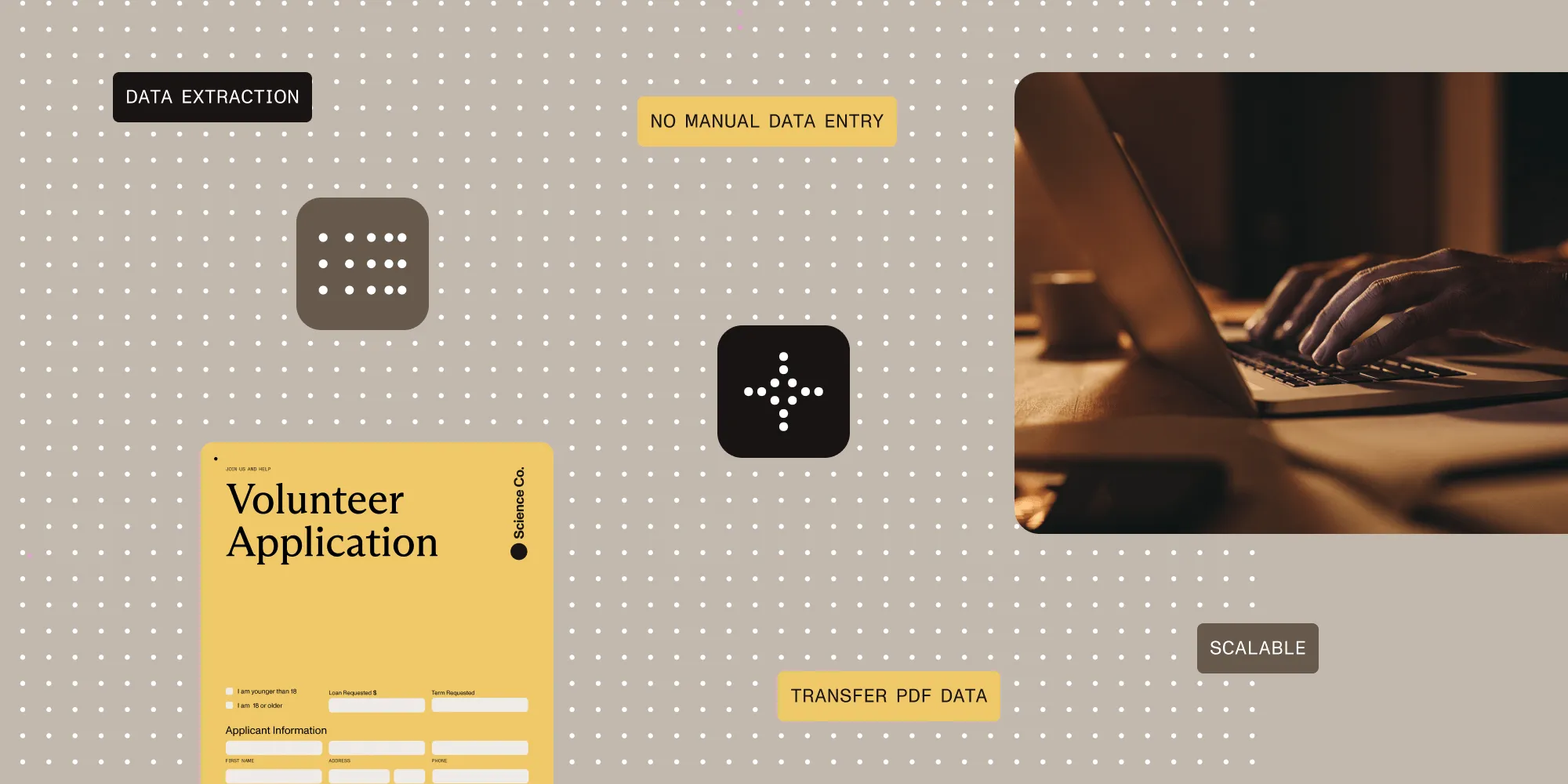What is document processing?
Table of contents

Document processing converts paper forms and analog data into a digital format for easy replication. After digitizing this data, organizations can extract data for online processes. There are two different types of document processing: manually and automated.
The latter is also sometimes referred to as intelligent document processing (IDP). While some organizations are still manually processing documents, automation is sweeping the space because organizations are working toward a complete digital transformation.
Automating this process is a way to manage documents easily throughout their lifecycle and can be used to improve efficiency, productivity, and compliance. Before AI, document processing systems were typically limited to only being able to recognize text. Still, now, with AI-driven solutions, IDP systems comprehend context, apply machine learning to adapt, and handle diverse document types.
This article will discuss software’s role in document processing, real-world use cases, software automation, benefits and challenges, and future trends.
The role of software in document processing
By using software for document processing, extracting and validating data and information becomes seamless. Software tools that use AI and machine learning have allowed organizations to process documents faster and more quickly. Machine learning is a subfield of artificial intelligence (AI), broadly defined as a machine’s capability to imitate intelligent human behavior.
The advantages
IDP software includes both AI and machine learning. There are many advantages of using software for document processes, outlined below.
Improved security
Paper files aren’t particularly secure and can easily be lost or stolen, but document management systems enhance security. They typically have robust security features that cover various topics related to data encryption, firewalls, authentication, regulatory compliance, private cloud details, architecture, database access, disaster recovery, and application updates.
Information retrieval
Searching through and finding information with just a few clicks is easier in the digital realm. If data and information are digitized as opposed to being in a manual format, information retrieval is much faster.
Increased productivity
Keeping documents in one centralized location increases productivity by manually reducing an employee’s time needed to look for information.
Version control
It’s hard to know which version is more recent when using manual forms. With document processing, this is no longer a challenge. The digital document can be versioned and easily accessible in the correct form for company-wide use, leading to improved compliance.
Better compliance
Many industries have strict document and record-keeping compliance requirements. Digital forms enforce consistent processes to match the policies and procedures within your organization or department. As compliance regulations continue to increase in both number and scope, the automation of compliance workflows has become critical.
Reduce errors
IDP reduces the number of humans needing to involve themselves in manual tasks. For example, when manually gathering information from a document, it’s easy to accidentally key in the wrong data. So, eliminating human error reduces inefficiencies.
Document processing tools
If you’re interested in which of our document processing tools might work for you, the following sections outline the various options.
Nutrient Workflow
Create unlimited innovative, complex business forms the way you want, with complete formatting and advanced layout tools in Nutrient Workflow. The interface is designed to manage processes visually.
AI Document Processing
With our AI PDF data extraction solution, you can attain human-level precision in data classification and extraction from diverse document formats without set rules or coding. Generative AI fused with machine vision technology ensures unmatched workflow accuracy and flexibility.
.NET SDK
Our .NET SDK offers solutions to manage electronic documents (locally or online):
- Extract text and MICR characters from scanned images
- Automatically export PDF table data to Excel
- Automatic document recognition and form processing
- View and convert documents in 100+ formats
- Image processing algorithms
- Intelligent document processing
PDF SharePoint solutions
Our low-code platform offers a complete suite of PDF tools for SharePoint with an easy-to-use online app and on-premises deployment. It features conversion to PDF, watermarking, hyper-compression, intelligent data extraction, merging, splitting and much more. Document Editor for SharePoint enables users to annotate, sign, redact, and edit documents without leaving SharePoint. Furthermore, it supports form creation and form filling capabilities.
OCR SharePoint solutions
Document Searchability is an automated OCR SharePoint solution that audits an entire SharePoint library and reports how many files are searchable, partially searchable, or non-searchable. As a next step, it performs OCR on partially searchable and non-searchable files, making all the documents in a SharePoint library findable and accessible. To further enhance findability, it automatically adds metadata tags to documents based on their content.
Use cases for document processing
The following sections outline a few common use cases for document processing.
Human resources: Automating employee onboarding
A company’s onboarding experience varies widely, especially as more workers are hired and onboarded remotely.
Making forms and procedures more accessible to distribute, process, and review with workflows for human resources (HR) can make a world of difference in your costs when onboarding and training new employees.
By digitizing this workflow, you can streamline the onboarding process and ensure it’s done the same way each time. This ensures consistency, accuracy, and accountability when onboarding different employees.
Finance: Streamlining invoice processing
Implementing document processing for your finance department removes barriers to running a high-performing team. Budget approvals, accounts payable, purchase requests, expense requests, invoice reconciliation, and other financial processes can be upgraded to automated workflows that ensure consistency and compliance.
Invoice processing is a specific example of a process that would benefit from digital transformation. By using software for document processing, data entry errors and process delays become a thing of the past. Document processing software can automatically extract data from invoices, validate it against purchase orders, and integrate with accounting software for payment processing.
Healthcare: Enhancing patient record management
For healthcare companies, compliance, accuracy, and accountability are critical. Document processing allows better internal controls and greatly improved efficiency.
Document processing can manage patient records, including medical histories, test results, and insurance information, in a secure location. It can help healthcare providers digitize paper records, organize digital documents, and ensure compliance with privacy regulations.
Automating document processing with software
Automated solutions like Nutrient Workflow allow for seamless document processing. The software lets you replicate your documents into smart forms and then add to a workflow process to streamline the process entirely.
By automating processes, information will be captured efficiently, ensuring accuracy. This is a massive step in the right direction compared to manually handling your documents. Automating workflows and documents, especially processes primarily handled manually by employees, can significantly improve efficiency, productivity, accuracy, accountability, and job satisfaction.
Using enterprise workflow software and automation, your business will save time and reduce errors.
Benefits of automated document processing
Enterprise automation doesn’t have to be complicated. Automated workflows can be designed visually to simulate or improve existing processes. Workflow automation provides several benefits over manual processes:
- Policy compliance adherence
- Reduced approval cycles
- Reduced manual handling
- Improved communication
- Improved visibility
- Improved employee satisfaction
- Continual process improvement
- Better workload management
- Reduced errors
Another benefit is that operational efficiency is possible when automating this procedure. The definition of operational efficiency or operational effectiveness in a business context is the degree to which an organization can deliver its goods and services with minimal waste.
Conclusion
In conclusion, document processing is undergoing a significant transformation driven by advancements in software technology, mainly through automation and intelligent document processing (IDP). This evolution from manual to automated processes streamlines operations and enhances organizational security, productivity, compliance, and efficiency. The role of software, including AI and machine learning, has revolutionized document processing by enabling seamless data extraction, validation, and management.
Automated solutions like Nutrient Workflow offer a glimpse into the future of document processing, where workflows can be visualized and optimized to improve policy compliance, reduce approval cycles, and minimize errors. With the ongoing digital transformation, organizations stand to gain from embracing automated document processing, not only in terms of operational efficiency, but also in ensuring accuracy, accountability, and employee satisfaction. As technology continues to evolve, future document processing trends are likely to further emphasize the importance of software-driven automation in achieving optimal business outcomes.
Nutrient Workflow can help your organization achieve operational excellence by using our software to digitize your documents. Contact us today for a personalized demo and see how we can make your organization more efficient.







